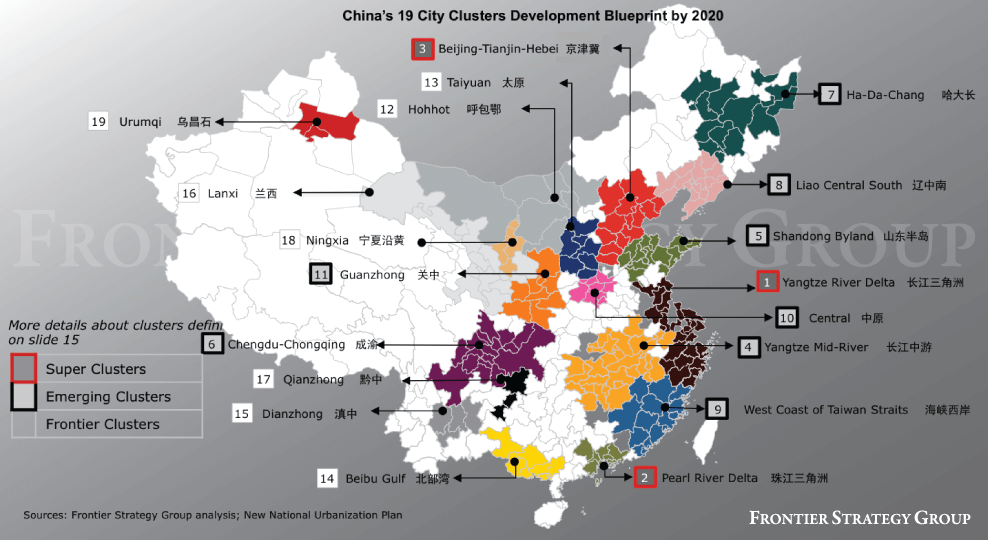As outlined in China’s 11th five-year plan, the Chinese government has pushed for the development of regional city clusters, aiming to drive economic growth, strengthen transportation, and influence the pattern of migrants. For those less familiar, city clusters are comprised of one or two cities, considered the nucleus, and several neighboring cities with well-connected transportation facilities. China already has several mature mega clusters such as the Yangtze River Delta centered in Shanghai and the Pearl River Delta anchored by Guangzhou, but new initiatives to continue city cluster development are underway.
Earlier this year, The Central Committee of the Communist Party of China together with the State Council released the New National Urbanization plan, a series of integrated, cooperative government initiatives to establish a more coherent city cluster plan. According to the document, China will have 19 clusters by 2020 as illustrated in the map above. The government intends to break the constraints of administrative divisions of these city clusters, realize the integration and consolidation of social and economic activities within vast areas, greatly reduce the distance and space between people, and promote human movement and economic activities at regional and national levels.
The formations of these metropolitan areas and urban clusters are changing and will continue to fundamentally change the way we look at China’s cities. In my previous post, I discussed China’s urbanization as a major driver for the future consumption-led economy. As China continues to urbanize, the inter- and intra-cluster’s connectivity and motilities, driven by the development of public transport infrastructure, city boundaries are increasingly blurring.
FSG has aligned the clusters’ definitions with the government’s plans. Of the 19 clusters, 3 super clusters have been targeted to become world-class economic zones. An additional 8 clusters are called emerging clusters, each composing as much as 3–9% of total GDP in 2013. The government aims to turn these clusters into national zones as key pillars of the Chinese economy. The remaining 8 frontier clusters are included in government’s 2020 cluster master plan but haven’t yet taken shape, each with equal to or less than 2% of total GDP. Apart from the well-known super clusters, 8 emerging clusters have already or will feature prominently in the national urbanization process. Among them, FSG has highlighted the Yangtze Mid-River cluster and the Chengdu-Chongqing cluster because we believe they are poised to be the upcoming super clusters.
FrontierView has all the information you need about your market, industry, and company in real-time to power your business decisions. We offer a solution that puts the right information at the right time, at your fingertips. If you would like more insights into your specific markets, click the “Start Free Trial” button on your screen to speak with a dedicated Client Services Manager and receive complimentary access to our offering.

